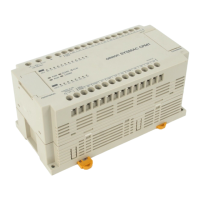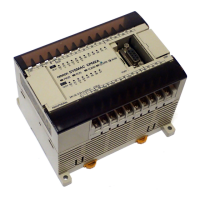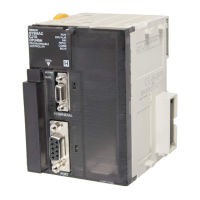311
5-21-17 SQUARE ROOT: SQRT(466)
(466)
SQRT S R
Ladder Symbol
Variations
↑SQRT(466)
Operand Data Areas
S: First source word CIO, G, A, T, C, #, DM
R: First result word CIO, G, A, DM
When the execution condition OFF, SQRT(466) is not executed. When the
execution condition is ON, SQRT(466) computes the square root of the 32-float-
ing-point content of S and S+1, and places the result in R and R+1.
R+1 R
S Source (floating-point data, 32 bits)
S+1
Result (square root, floating-point data, 32 bits)
If the absolute value of the result is greater than the maximum value that can be
expressed for floating-point data, the Overflow Flag (A50009) will turn ON and
the result will be output as ±.
Relation Between Input Data and Result
S: Input data
R: Result
R
Precautions S and S+1must be non-negative floating-point data.
Note Refer to page 115 for general precautions on operand data areas.
Flags ER (A50003): S and S+1is a negative number.
S and S+1is not floating-point data.
The content of a*DM word is not BCD when set for BCD.
EQ (A50006): The exponent and mantissa of the result are 0.
N (A50008): OFF when the computation is executed.
OF (A50009): The absolute value of the result is greater than the maximum
value that can be expressed for floating-point data.
UF (A50010): OFF when the computation is executed.
Description
(CVM1 V2)
Floating-point Math Instructions
Section 5-21

